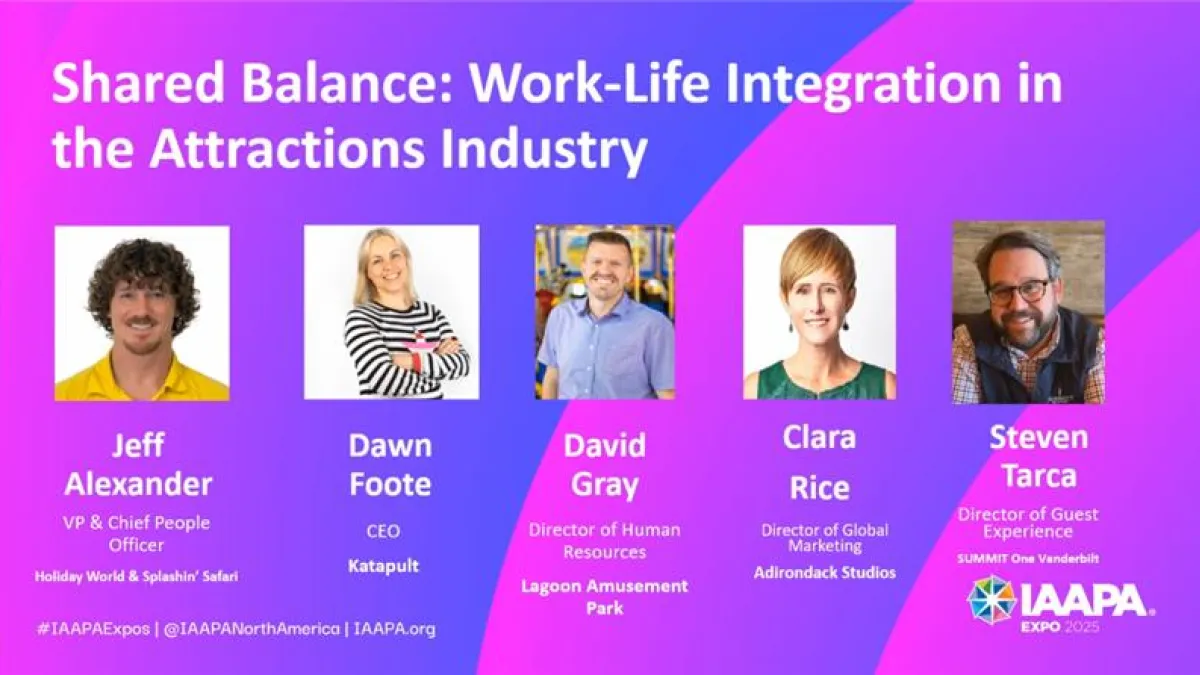Tour button
EDUSession: Mastering Work-Life Integration
How ambitious attractions professionals create healthy and balanced lives

“Life’s too short; do you want your life to be measured in connections or keystrokes?”
Those words by Clara Rice, director of global marketing at Adirondack Studios, were among the enduring messages of an EDUSession titled Shared Balance: Work-Life Integration in the Attractions Industry on Monday of IAAPA Expo 2025.
While work-life balance creates a clear separation between the two, work-life integration promotes that work is a part of life, and flexibility is key.
“Integration can become a shared responsibility between individuals and organizations,” says Lagoon Amusement Park Director of Human Resources David Gray, who moderated the panel. “We don’t want anyone to have to make that choice of one or the other.”
“My family is more important than my job; I will not neglect my job, but family is my priority,” Holiday World and Splashin’ Safari Vice President and Chief People Officer Jeff Alexander says. “Part of making both work is managing your calendar. Be mindful of when you schedule meetings in order to build flexibility into your day.”
In the attractions industry, flexibility is even more important since most businesses are operating outside of traditional business hours. Tools like shift swapping can help people schedule around times when employees may need to attend to personal matters. As an employer, that can also mean adjusting someone’s schedule to accommodate duties at home.
“We have a responsibility to the people we hire. Have individual conversations to see where the work-life struggles might begin,” says Steven Tarca, senior director of guest experience at Summit One Vanderbilt. “If someone is habitually late, find out why. They may be poor planners, or they may be facing a challenge at home that can be solved by shifting their schedule.”
Each member of the panel spoke about their varying strategies to achieve work-life integration, and many learned the hard way through personal struggles that forced them to adapt.
“It’s a work in progress; no one is an expert at this,” Rice says. “I put my phone down at 5 p.m., and my husband and kids check me on this.”
Dawn Foote, cofounder and CEO of Katapult, explains that a medical emergency involving her husband while she was pregnant was her moment when everything changed.
“My whole perspective in my journey shifted. Every issue at work is something you can figure out and sort through. If it was going to spend time away from my family, it was going to be meaningful, and it changed me as a leader,” Foote shares.
The panelists also discussed ways to get senior leadership on board with making work-life integration a priority.
Alexander says engagement surveys—and following up on the results—can help companies face issues head on, which help leaders understand issues important to employees. “People, processes, tools, and training can all lead to better work-life integration,” he emphasizes.
“Show data about the financial implications of high turnover,” Rice says, “but reputation is also important. In an industry where everyone seems to know one another, you don’t want to be known as not being a fun place to work.”
In the end, Tarca says it starts with each leader as an individual—whether that means taking time for self-care or connecting with team members on a deeper level to show genuine care.
“If we can’t take care of ourselves, we can’t take care of each other, and we can’t take care of our guests,” Tarca says.

Funworld delivered complete coverage of IAAPA Expo 2025 on one updated page, featuring breaking press conference announcements, EDUSession insights, and Expo news that kept the global attractions industry informed during Orlando’s biggest week.
Follow IAAPA for news and event announcements in your favorite social media apps
Connect with the Real Stories Behind the Fun
Follow our social media for authentic stories, special moments, and behind-the-scenes looks from the attractions world.












 The Official Magazine of IAAPA
The Official Magazine of IAAPA